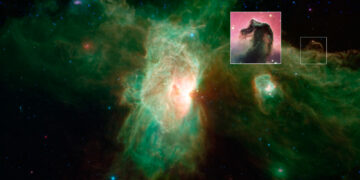Dimethyl sulfide (DMS) has long been a fascinating molecule in the search for extraterrestrial life because on Earth, it is almost exclusively produced by living organisms. This made DMS a strong candidate as a biosignature—a chemical sign that life might exist elsewhere. Recently, astronomers detected DMS in the atmosphere of K2-18b, an exoplanet located about 120 light-years away in the constellation Leo. Initially, this fueled excitement about the possibility of alien life.
K2-18b: A Promising Candidate for Life
K2-18b is particularly intriguing because it orbits within the habitable zone of its host star, a red dwarf, where temperatures might allow for the existence of liquid water. Classified as a Hycean world—a type of planet with a hydrogen-rich atmosphere and a potentially ocean-covered surface—K2-18b fits many criteria that scientists associate with habitability.
In 2023, the James Webb Space Telescope (JWST) detected methane, carbon dioxide, and even signs of water vapor in its atmosphere, raising hopes that K2-18b might be capable of supporting life (NASA, 2023). The detection of DMS seemed like the final piece of a thrilling cosmic puzzle—until scientists began questioning its origin.
The DMS Discovery: A Double-Edged Sword
Finding DMS in the atmosphere of K2-18b was, at first glance, a breakthrough moment. On Earth, DMS is produced almost entirely by marine phytoplankton and other microorganisms. Its presence elsewhere in the universe could hint at similar biological processes. However, as excitement grew, so did the skepticism.
Could DMS form without life? Scientists knew that while certain molecules, like methane, could have geological sources, DMS was traditionally seen as a cleaner signal, less likely to be produced abiotically. But emerging evidence suggested otherwise, urging a reassessment of how we define and interpret biosignatures.
New Research: Abiotic Formation of DMS in Space
In a pivotal study led by Gabriella Di Genova from the University of Grenoble, researchers used quantum chemistry and chemical kinetics to investigate possible non-biological pathways for DMS formation . ‘
They modeled how chemical reactions might unfold in the cold, dense regions of space known as molecular clouds. Their findings revealed that three distinct gas-phase reactions could feasibly produce DMS without any biological involvement. These reactions are particularly likely in areas such as the Galactic Center Cloud G+0.693-0.027, where conditions are ripe for complex chemistry. The discovery that DMS can emerge naturally from interstellar chemistry shakes the foundation of how scientists link certain molecules to life.
The Science Behind Abiotic DMS Formation
Understanding the chemistry of space is no small task. Molecular clouds are frigid regions, often just a few tens of degrees above absolute zero, filled with dust and gas. In these conditions, complex molecules can form on the surfaces of icy dust grains or through collisions in the gas phase.
The study found that reactions involving methanethiol (CH₃SH) and protonated methanol (CH₃OH₂⁺) are particularly efficient at forming DMS. Interestingly, sulphur-based reactions tend to have two competing pathways, unlike their oxygen-based counterparts, leading to slightly slower but steady DMS production.
At higher temperatures, reverse reactions can dominate, but in the cold of molecular clouds, forward reactions favor the buildup of DMS. This discovery opens the door to understanding how a molecule thought to require life could actually be born among the stars.
Comets, Clouds, and Cosmic Chemistry
Evidence supporting the abiotic formation of DMS doesn’t just come from theory. Observations of cometary outgassing—the process where frozen gases are released as a comet approaches the Sun—have detected DMS in comet Hartley 2 and others (NASA, 2011). These detections strengthen the case that DMS can form without life, through natural processes in space.
In fact, the chemical environment of comets closely mirrors that of molecular clouds, further bridging the connection between interstellar chemistry and solar system observations. What was once considered an exclusively biological molecule now appears to have a broader cosmic origin story.
Implications for Astrobiology: Rethinking the Rules
The realization that DMS can form abiotically carries profound implications for the search for extraterrestrial life. Scientists must now reconsider how they interpret potential biosignatures detected on distant exoplanets.
A single molecule, no matter how biologically significant it may seem on Earth, is no longer sufficient evidence. Instead, a suite of biosignatures—a pattern of molecules consistent with life—will be needed to make a convincing case.
This also places greater emphasis on the importance of planetary context: atmospheric composition, surface conditions, and stellar environment all influence whether a molecule points to biology or chemistry alone.
The Role of Quantum Chemistry and Advanced Modeling
One of the most exciting aspects of this discovery is how it showcases the power of quantum chemistry and computational astrophysics. By simulating reactions on a molecular level, scientists can predict the behavior of atoms and molecules under extreme conditions.
These tools allow researchers to explore environments that are otherwise inaccessible, like the interiors of molecular clouds or the atmospheres of exoplanets. Computational chemistry has now become an indispensable tool in astrobiology, offering a way to test hypotheses and guide observational campaigns with telescopes like JWST and the upcoming Extremely Large Telescope (ELT).
Future Research Directions: Where Do We Go From Here?
Moving forward, scientists will aim to refine models of abiotic chemistry even further, exploring other potential pathways for biosignature-like molecules. Laboratory experiments simulating interstellar conditions could validate theoretical predictions, while future missions might directly sample comets, asteroids, and even planetary atmospheres.
Instruments like JWST will continue to search for complex molecules on exoplanets, but researchers will interpret these findings through a more cautious and holistic lens. Cross-disciplinary collaboration between chemists, astronomers, planetary scientists, and biologists will be key to unlocking the secrets of life beyond Earth.
Conclusion: A New Era of Discovery and Caution
The story of DMS in space serves as a reminder that the universe is endlessly surprising. Just when we think we have a clear marker for life, new discoveries challenge our assumptions and push the boundaries of our understanding.
Reference:
Gas-phase formation routes of dimethyl sulfide in the interstellar medium



















